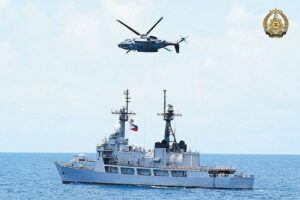MANILA’s joint patrols with its allies in the South China Sea show resistance to Beijing’s “bullying” in the waterway amid rising tensions over its disputed features, a Philippine senator said on Monday.
“It shows that we who believe in the rule of law will not tolerate any form of violence, threat, or intimidation,” Senator Ana Theresia N. Hontiveros-Baraquel said in a statement.
“I do think that these help put China in her place.”
The armed forces of five countries conducted joint maritime exercises in a portion of the South China Sea on Saturday as China carried out its own military drills in the disputed waterway, Reuters reported on Saturday.
The exercises involving the Philippines, United States, Australia, Japan and — for the first time — New Zealand took place in Manila’s exclusive economic zone and sought to improve the militaries’ interoperability, the Philippine armed forces said in a statement.
Philippine military chief General Romeo S. Brawner earlier said the patrol affirmed the right to freedom of navigation and overflight over the South China Sea.
The Chinese Embassy in Manila did not immediately reply to a Viber message seeking comment.
Australia’s Department of Defense said the drills demonstrated “our collective commitment to strengthen regional and international cooperation in support of a peaceful, stable and prosperous Indo-Pacific,” Reuters reported.
Australia has “consistently pressed China on peace and stability in the South China Sea and Taiwan Strait,” Australian Foreign Minister Penny Wong said in a speech to the United Nations General Assembly on Saturday.
“We have welcomed the resumption of leader and military level dialogue between the US and China,” Ms. Wong said, according to a transcript.
According to the US Naval Institute website, the joint patrol saw participation from vessels such as Manila’s BRP Antonio Luna, BRP Emilio Jacinto, while Washington’s USS Howard, Canberra’s HMAS Sydney, Tokyo’s JS Sazanami, and Wellington’s HMNZS Aotearoa.
Tensions between the Philippines and China have worsened in the past year as Beijing continues to block resupply missions to Second Thomas Shoal, where Manila has a handful of troops stationed at a beached vessel.
In 2016, a Hague-based arbitration court upheld the Philippines’ rights to its exclusive economic zone within the waterway. It rejected China’s claim to most of the sea based on a 1940s nine-dash line map that Philippine Foreign Affairs Secretary Enrique A. Manalo has said “had no basis in law.
Mr. Manalo in his speech before the UNGA at the weekend also pushed for the peaceful and diplomatic resolution of territorial disputes, citing the importance of upholding a rules-based international order. He also batted for support for the country’s bid for a non-permanent seat in the UN Security Council between 2027 and 2028.
Manila has been unable to enforce the ruling and has since filed hundreds of protests over what it calls encroachment and harassment by China’s coast guard and its vast fishing fleet.
Ms. Hontiveros urged Chinese government to abide by its commitments to the United Nations Convention on the Law of the Sea (UNCLOS) and the UN agreement on Marine Biological Diversity of Areas Beyond National Jurisdictions (BBNJ)
BBNJ entails international cooperation in promoting environmental impact assessments and capacity-building in the transfer of marine technology.
Last month, the US and French navies held war games in the Philippine Sea to advance their interoperability “in support of a free and open Indo-Pacific,” according to the US 7th Fleet.
Manilla, Washington, Ottawa and Canberra held their first joint military exercises in the South China Sea on Aug. 7 and 8 amid Beijing’s increased military buildup in the waterway.
Congress earlier passed a bill seeks to set up Philippine sea lanes and another establishing maritime zones to assert the country’s territorial claim over the South China Sea. Lawmakers have also passed a bill that tasks the government to draft a plan to manage marine and coastal resources to cut land and sea-based pollution and overfishing.
“It has always been clear that it is China who is provoking tensions in the West Philippine Sea — not us — so it is China who must stop her aggression,” Ms. Hontiveros said.
“These exercises demonstrate the commitment of the international community to uphold the rules-based order in the entire South China Sea.”
Manila and Beijing have resumed bilateral talks on easing tensions in the waterway, despite both sides insisting on upholding their claims over disputed features.
They have also traded accusations of ramming into each other’s vessels just after reaching a pact on resupply missions to a beached Filipino naval ship at Second Thomas Shoal. — John Victor D. Ordoñez with Reuters
